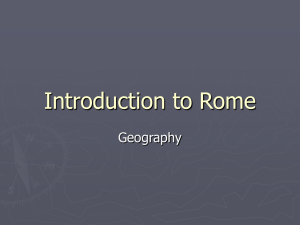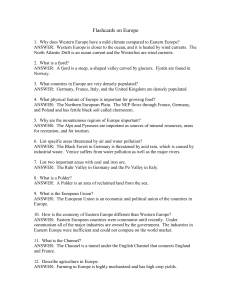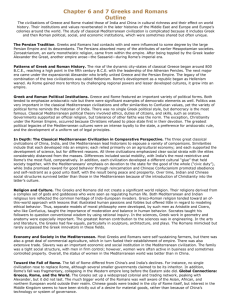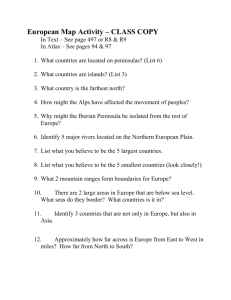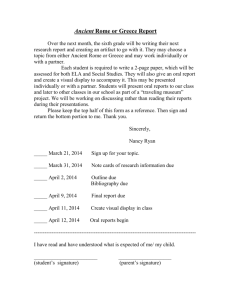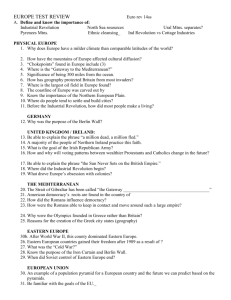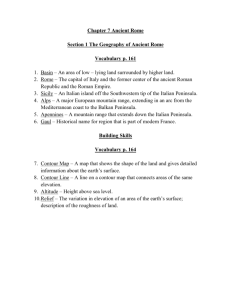Europe
advertisement
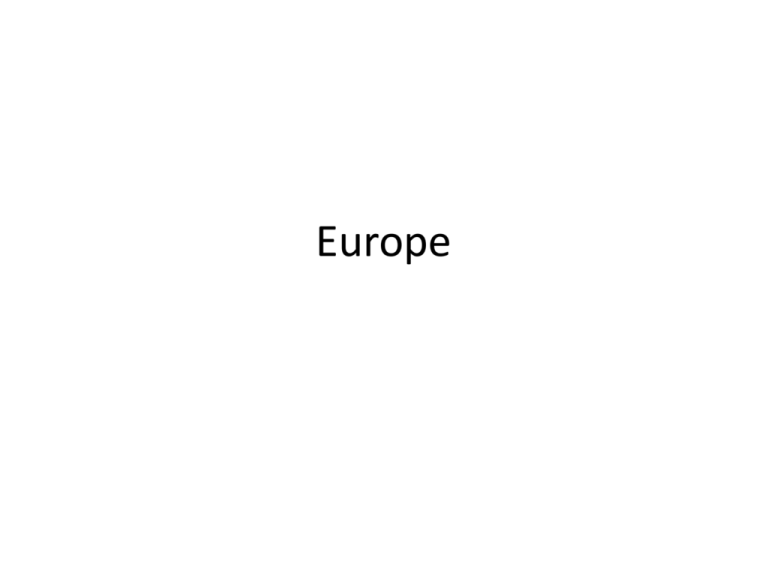
Europe Europe • The world’s second smallest continent • Located in the northern hemisphere • Huge diversity of landforms and cultures Regions of Europe • • • • • Western Europe Eastern Europe British Isles Northern Europe Mediterranean Europe Landforms and Resources • Peninsulas – Europe is a large peninsula stretching to the west of Asia – Europe as several small peninsulas – Major European peninsulas • • • • • Scandinavian Peninsula Jutland Peninsula Iberian Peninsula Italian Peninsula Balkan Peninsula Islands • • • • • • • • Great Britain Ireland Iceland Greenland Corsica Sardinia Sicily Crete Mountains and Uplands • • • • Alps Pyrenees Apennine Mts. Balkan Mts. Rivers and Fertile Plains • Danube- cuts through the heart of Europe from west to east – Touches 9 countries • Rhine- flows 820 miles from interior to the North Sea • Northern European Plain- one of the most fertile agricultural regions in the world – Stretches across France, Belgium, the Netherlands, Denmark, Germany, and Poland Resources • Coal and Iron • Energy – Oil and natural gas beneath the North Sea – Norway, the Netherlands, the United Kingdom, and Denmark pump oil from rigs – The North Sea fields are major sources of petroleum for the world • Agricultural land – 33% of Europe’s land is suitable for agriculture (world average is 11%) – Produce a variety of crops- grains, grapes, olives, cork – Timber Climate • Westerly winds warm Europe – Most of Europe is marine west coast climate – The nearby ocean and dominant winds create the mild climate – North Atlantic Drift- current of warm water from the tropics, flows near Europe’s west coast – Prevailing westerlies blow west to east, pick up warmth from this current and carry it over Europe – Also carry moisture- giving the region adequate rainfall Climate and Vegetation • Far from the Atlantic- Sweden, Finland, eastern part of Poland, Slovakia, and Hungary, and all of Romania have a humid continental climate – Cold snowy winters and either warm or hot summers – Adequate rainfall Climate and Vegetation • Sunny Mediterranean – Southern part of Spain and France through Italy to Greece and other parts of the Balkan Peninsula – Hot dry summers • Exception- Mediterranean France- not protected by high mountains – In winter most of this coast receives mistral (cold and dry) winds from the north Climate and Vegetation • Most of the Mediterranean countries experience a wind called the sirocco- hot, steady south wind that blows from North Africa across the Mediterranean Sea into south Europe – Produces rain Assignment • Create a country snapshot based on one country in Europe. • The information you collect will be used in group discussions so make sure you collect enough information. Snapshot Physical Geography Political Social Economic Freebie Location Discussion Questions 1. Explain your country to your group. 2. Why do you think Switzerland did not become a maritime leader as opposed to England, Spain, Portugal, and Norway? 3. What are the unique physical features, climates, and resources of Europe's nations? 4. How does the physical location of a nation affect its political, social, and economic characteristics? 5. How does the physical geography shape a nations culture? Human-Environment Interaction • Venice, Italy- more than 150 canals – Almost anything that is moved on wheels elsewhere is moved by water in Venice – Located at the north end of the Adriatic Sea- trade helped Venice grow – Swampy land- made construction more difficult • Causes the city to gradually sink Human-Environment Interaction • Deforestation- clearing forests from an area – Europe has lost huge areas of forests – Acid rain strips forests • Factories produce high amounts of sulfur dioxide and nitrogen oxide emissions • These combine with water vapor and oxygen to form acid rain or snow Urbanization • Europe is among the most highly urbanized regions of the world • 73% of Europeans live in cities • West is more urbanized than East • Most urbanized countries • Belgium, Iceland, United Kingdom, Germany, France • Least urbanized country • Albania ©2012, TESCCC Urbanization • European urban areas are like suburban areas in the United States • European cityscapes differ from North American cities due to: • Long histories • Scarce land • Strong government control of urban land development ©2012, TESCCC Population • 3rd largest population cluster • High Population densities in western Europe • Nordic Europe very sparsely populated ©2012, TESCCC Changing Population • Population falling • Fertility at all-time low • Fewer young people ©2012, TESCCC • Smaller working age population • Immigration offsetting losses Human-Environment Interaction • The Netherlands- the Dutch needed more land for their growing population so they reclaimed land from the sea – At least 40% of the Netherlands was once under the sea – Polder- land that is reclaimed by diking and draining While reading the article take notes on page 62 or 63. Use these questions to guide your notetaking. • How is acid rain affecting Europe? • What is contributing to the problem? • What other problems (non environmental) can acid rain cause? • What are some ways that Europeans can solve the issues caused by acid rain? Mediterranean Europe- “All roads lead to Rome” • Home to the two great civilizations of ancient Europe – Ancient Greece and ancient Rome • Mild climate made it easier for people to settle and survive • Mediterranean Sea encouraged overseas trade Mediterranean Europe • Greece- birthplace of democracy • 2000 B.C.- people moved from the north to the Balkan Peninsula • Mountainous region so the cities and villages were very isolated from each other and developed into separate city-states. • City-state- political unit made up of a city and its surrounding lands Mediterranean Europe • Ancient Greece left a lasting impact on modern life – Athens developed the first democracy (government in which people rule) – Athenian democracy helped inspire the U.S. system of government – Greek science, philosophy, drama, and art helped shape modern culture – In the 400s B.C. conflict made Greece weak • Several city-states fought costly series of wars with Persia- an empire in southwest Asia • Athens also fought a war with Sparta- a rival Greek city-state • Finally in 338 B.C., Macedonia conquered Greece and in 336 B.C. Macedonia general Alexander the Great conquered Persia and part of India. • His empire spread Greek Culture but broke apart after his death. Mediterranean Europe • The Roman Empire – As Greece was losing power, Rome (west) was rising – Rome ruled most of the Italian Peninsula by 275 B.C. – Rome was a republic- government in which citizens elect representatives to rule in their name – The Roman Empire grew by conquering territory overseas, including the Iberian and Balkan Peninsulas – Republic ended when an emperor took control of Rome – Spread Christianity (Rome’s official religion) – By A.D. 395, the empire was too large so it split into a western and eastern half – Western Rome fell in A.D. 476 because of German invaders – Eastern Rome lasted for about 1,000 more years Mediterranean Europe • Crusades – 1096, European Christians launched the crusades- a series of wars to take Palestine from the Muslims – https://www.youtube.com/watch?v=X0zudTQelzI • The Renaissance – A time of renewed interest in learning and the arts that lasted from the 14th-16th centuries – Inspired by classical art and writings – Bubonic plague reached Italy from Asia and killed millions of Europeans (we’ll spend more time on this tomorrow) Mediterranean Europe • Spain’s Empire – 700s- Muslims from North Africa conquered the Iberian Peninsula – Muslims controlled the region for more than 700 years – In 1492, Spain’s Catholic rulers, Ferdinand and Isabella took retook Spain from the Muslims – The empires spread Catholicism and the Spanish and Portuguese languages throughout the world Mediterranean Europe • Culture – Greek, Portuguese, Spanish, and Italian – Eastern Orthodox and Roman Catholicism – Classical statues, Renaissance painting and sculpture Mediterranean Europe • Political turmoil in the 20th century – Two dictators- Benito Mussolini in Italy and Francisco Franco in Spain – They both ruled for long periods of time – Fascism- government has complete control over peoples lives and they are not allowed to disagree with the government – After WWII- Italy became a republic Activity • Complete the reading on the Crusades and the assignment that follows. Western Europe • Dominant countries- France and Germany – Both places have strong cultures that spread over Europe • Charlemagne- Germanic king- he conquered most of the region – His empire declined after his death – Western Europe remained a region of small, competing kingdoms Western Europe • Reformation – Religious movement – Many Christians broke away from the Catholic Church and started Protestant churches – Hostility between Catholics and Protestants to fight religious wars that tore Europe apart – Today people still are mainly Catholic and Protestant in western Europe Western Europe • Period between fall of Rome and the Renaissance= the Middle Ages • Nation-state- an independent nation of people with a common culture • After Rome fell – Feudalism gradually developed Europe • A political system in which powerful lords owned most of the land • They gave some land to nobles in exchange for military service by those nobles – Nationalism developed- the belief that people should be loyal to their nation, the people with whom they share land, culture, and history Western Europe • Late 1600’s- French kings held absolute power • The French Revolution- 1789 – Napoleon Bonaparte seized power and made himself Emperor. He tried to conquer all of Europe but was defeated • Nation-states of Europe became rivals • Experienced industrial growth in the late 1800s • Industrialism caused European nations to set up colonies around the world Western Europe • Nationalistic conflict rivalry and competition helped to cause WWI. • Allied Powers (France) found the Central Powers (Germany and Austria-Hungary) • Allied Powers won and imposed harsh terms on Germany • German resentment helped to cause WWII Western Europe • WWII- Germany, led by Hitler and the Nazis, tried to conquer Europe • Holocaust- A program of mass murder of European Jews and other minorities • Allies defeated Germany and Germany was split into two nations- East Germany (aligned with Communist) and West Germany – The two nations were divided by the Berlin Wall – In 1989, anti-Communist reforms swept Europe and East Germany opened the Berlin Wall – 1990- the two Germanys reunited under a democratic government Western Europe • Regions economy is strong- includes agriculture, and manufacturing, plus high-tech and service industries • The region has three of Europe’s top manufacturing nations: France, Germany, and the Netherlands • Tourism is also a major part of the regions economies. • (We’ll talk more about economics in the region next week- The European Union) Western Europe 1. What is a nation state? 2. How did nation-states emerge from feudal societies? 3. How was Germany divided and then re-united? 4. Why are France and Germany the dominant counties of Western Europe? 5. How did language differences develop in Western Europe? 6. What economic challenge does Germany face? Vocabulary Quiz Tomorrow • • • • • • • • • • • City-state Republic Crusades Renaissance Aqueduct Reformation Feudalism Nationalism Democracy Holocaust Berlin Wall • • • • • Parliament Satellite nation Market economy Anti-Semitism Ethnic cleansing Northern Europe • The United Kingdom, Ireland, and Nordic countries: Denmark, Finland, Iceland, Norway, and Sweden • History of seafaring conquerors Northern Europe • Great Britain’s influence – Developed representative government • Parliamentary Monarch • Ideas spread to the U.S., Canada, and various British colonies – Industrial revolution • Iron ore and coal Northern Europe • Nordic countries did not involve themselves in other nations’ affairs • Britain played major role in world wars (Allies). • British involvement in other parts of the world – Colonies – Lasting affects Northern Europe • Economy – Highly developed – Manufacturing and traditional economic activities like fishing and forestry – High-tech industries Northern Europe • Most people live in cities and have high standard of living • Nordic countries have many welfare systems for their families – Families are given allowances – National health insurance programs – People in these places pay very high taxes Homework Quiz B 1. How do language and religion reflect the cultural division in Western Europe? 2. How did the the Reformation affect Northern Europe? 3. How does the economic strength of a nation affect its willingness to welcome immigrants? 4. Why is there conflict in Northern Ireland? Eastern Europe • Albania, Bosnia and Herzegovina, Bulgaria, Croatia, the Czech Republic, Hungary, Macedonia, Poland, Romania, Slovakia, Slovenia, Yugoslavia • Cultural Crossroads- place where various cultures cross paths – People moving between Asia and Europe have crossed this region- traders, nomads, migrants, and armies • The region was controlled by Empires for a long time so the rise of independent nations was slow Eastern Europe • Centuries of foreign rule led to ethnic groups guarding their identities – Sparked many conflicts in the 20th century • 1912- Greece, Bulgaria, and Serbia went to war against the Ottomans • 1913- Balkan countries fought over territory ownership- led to balkanization- the process of a region breaking up into small, mutually hostile units Eastern Europe • 1914- A Serb assassinated an Austrian noble, sparking WWI • Ottoman Empire ended and is now Turkey-1923 • During WWII the Soviet Union gains control over much of Eastern Europe – Set up satellite nations- nations dominated by another country – The Soviet Union controls most of Easter Europe for 4 decades Eastern Europe • Instability followed after the Soviet Union lost power • After communist party people returned to ethnic loyalties. – Caused conflict Eastern Europe • Economy – After 1989- most Eastern European countries began to move toward a market economy – Some countries have had problems making economic progress • Old equipment • Lack of funds • Civil wars • Eastern Europe is much less urbanized than the rest of Europe – As industry grows so will the cities Activity • In your groups… 1. Look over the Bosnia timeline together. 2. Discuss the questions on your desks. (Number 3 must go on a separate sheet of paper) – Remember your grade is based on how much I hear you discussing the CONTENT!!! Discussion prompts 1. What is genocide? 2. How can nationalism lead to war? 3. Create a five-event timeline. Name 5 events that occurred during the war. 4. Compare and contrast genocide and ethnic cleansing. 5. What region in the world are we talking about here? Draw this chart in your notebook! Issue Climate Change Land Use Air pollution Biodiversity Urban Growth Water Explain the issue. What is happening? How can we fix it? 1951 – France and West Germany gave control of their coal and steel resources to a multination group called the European Coal and Steel Community 1993 European Union created The EU is similar to NAFTA Encourages trade among the member nations • Common currency called the Euro replaced national currency. • Workers are free to move throughout the EU zone. • EU law supersedes sovereign laws. What would be some of the concerns people would have about these? The alliance is expanding . . . Eastern European countries have begun to join the EU Warm-up 1/29 What do you already know about the Bubonic Plague? What is it? Where did it happen? When did it happen? How was it spread? • https://www.youtube.com/watch?v=XK9403xl PuE Warm-up 2/3 • Promote what you love instead of bashing what you hate. • Answer the questions on your warm-up paper based on the quote above.
